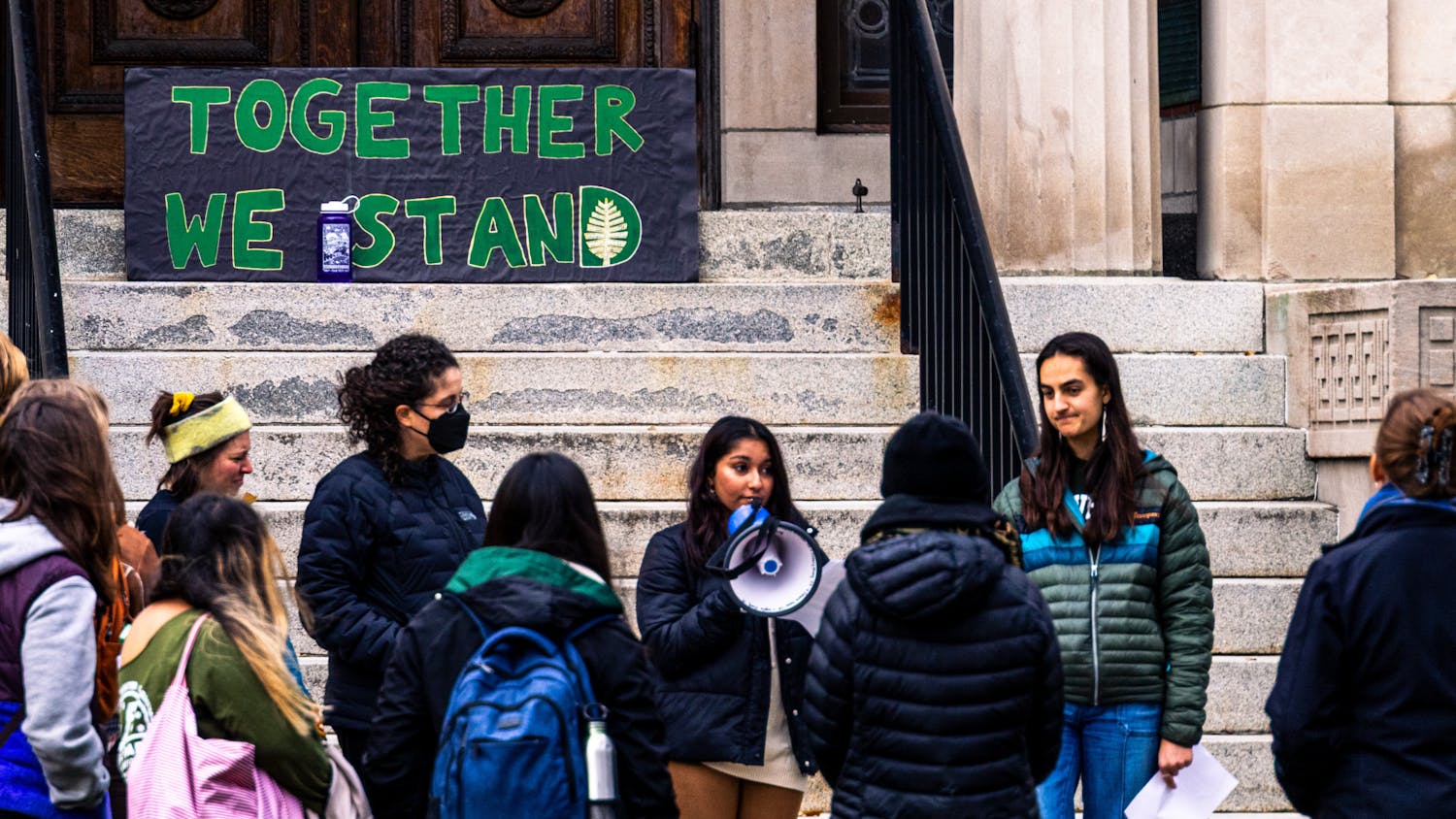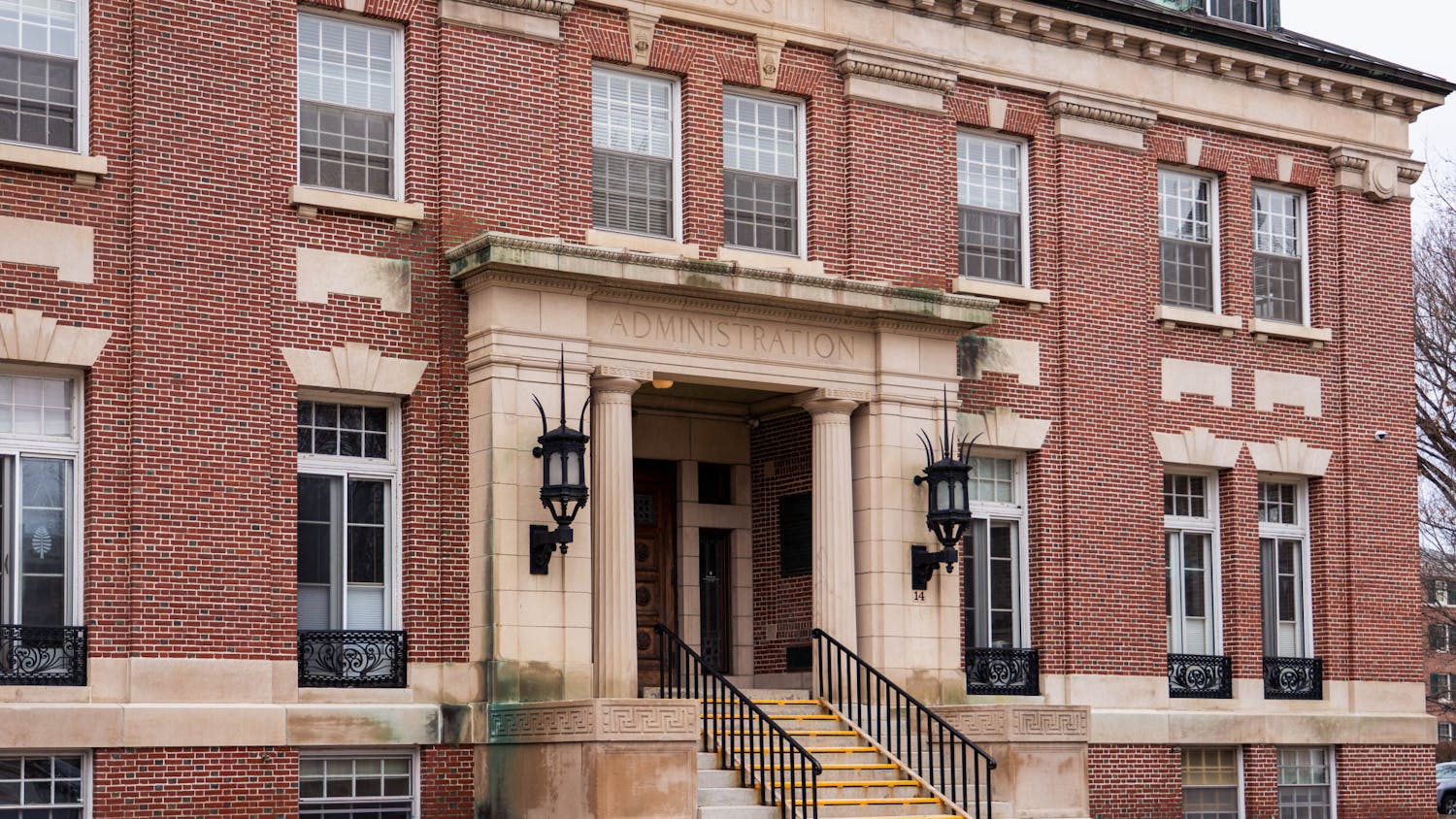The artwork of Iranian-born, Brooklyn-based artist Bahar Behbahani has found a home at the Hood Downtown at 53 Main Street. On Jan. 12, a student reception at the art space allowed students to explore Behbahani’s creations in the company of the artist herself. The exhibition, titled “Let the Garden Eram Flourish,” is the second installment in a series of exhibits at the Hood Downtown.
“Let the Garden Eram Flourish,” which consists of paintings, an installation and a video, brilliantly employs the motif of the famed Persian gardens to explore multiple themes, including identity and geopolitics.
John Stomberg, director of the Hood Museum, called Bahar’s mark-making extraordinary.
“She is very brilliant, but she is also an intuitive painter,” Stomberg said. “She’s never on auto pilot — every piece of paint has been thought through. She carries on the legacy of true painting.”
Behbahani’s paintings in the exhibit celebrate the splendor of Persian or Iranian gardens. Boasting flourishing, lush vegetation within their walls, these gardens are almost anomalies amid the arid climate that surrounds them, relying on carefully engineered canals and irrigation networks to generate life. These constructions have thus naturally become iconic symbols of Iran’s history. The eponymous “Let the Garden Eram Flourish” painting, for example, features heavily detailed depictions of the water pools, flora and architectural structures that are integral parts of Persian gardens.
However, Behbahani takes her work one step further by urging her audience to look beyond the visual appeal of the gardens. She explores the gardens to facilitate a broader, larger examination of their significance and her own identity, she said.
“[There is] the notion of public and private,” Behbahani said. “So we’re talking about who these gardens served really — the royal family or the people?”
Her series is the product of intense research Behbahani conducted around the subject of Persian gardens. Poetry, in particular, was one of the focal aspects of the artist’s investigation, as the gardens have long captured the awe of both native and Western poets. The title of the exhibition itself is derived from an ode by an early 19th-century poet Ali Khan dedicated to the Eram Garden, a UNESCO World Heritage site in Shiraz, Iran that is also known as the Garden of Paradise. Another poet whose work strongly influenced Behbahani is the famed 14th-century Persian poet Hafez.
Ugochukwu-Smooth Nzewi, the curator of the exhibition and of African art at Dartmouth, identified a potent relationship between the gardens and poetry.
“When you think about a Persian garden, the first thing that comes to mind, beyond the physical structure, is the way it plays with emotion,” Nzewi said. “And when you think about emotion, you think about poetry.”
Another area of Behbahani’s research that formed her creative direction was the embroilment of politics in the gardens’ history. Her findings regarding the life of American academic Donald Wilber, whom she knew as a well-established scholarly authority on Persian architecture in Iran, especially impacted this exhibition. She discovered Wilber’s role as the alleged architect behind the 1953 coup in Iran that overthrew the country’s democratically-elected prime minister Mohammad Mossadeq.
Behbahani said that painting the imagery of the garden helped her understand the stark duality of Wilber’s personas and the coup.
“[Painting this series] is a meditative gesture of the political subject through the process of creating these seductive, beautiful paintings.” Behbahani said. “I also had to review all the political and not very pleasing facts I was researching.”
The artist’s incorporation of imagery related to the coup is noticeable in the centerpiece painting, “The Decisions Are Made: Activity Begins.” The large black lines painted on the canvas represent the redacted sections of the CIA’s declassified documents revealing U.S. involvement in the coup. Some of the documents are also displayed in an installation that serves as a timeline of Behbahani’s research.
According to Nzewi, the timeline offers an instructive service to the viewers.
“It’s important that we don’t lose sight of our teaching mission when we make an exhibition,” Nzewi said. “We have something that provides [the viewers] textual context of the exhibition.”
A fascinating feature of the timeline is that its events are not sorted chronologically. Behbahani explained this concept in terms of her memories.
“I treat [the subject] as my own memory, which does not always go chronologically,” Behbahani said. “It’s like fragmented portions of my memory and time and history.”
History is perhaps the one central theme encompassing the different elements of the exhibition. In essence, “Let the Garden Eram Flourish” grapples with the different ways the Persian gardens have been depicted in history, both in an Iranian and global context.
“History as we know is a set of different perspectives,” Nzewi said. “It is the perspective of the conqueror, the winner. It is the response by the underdog. History flirts with fact.”
While Behbahani’s artwork is motivated by her personal exploration of identity and supported by heavy thematic concerns, she does not circumscribe her artworks within her own ideas and intentions. On the contrary, the artist actively invites and encourages viewer participation and interpretation.
“I deliberately make everything as fluid as I can,” Behbahani said. “So I just keep the conversation open for imagining and reimagining discourses.”
The exhibition is open Wednesdays through Saturdays from 11 a.m. to 7 p.m. and Sundays from 1 p.m. to 5 p.m. It will remain on display from Jan. 5 to Mar. 12. Admission is free.



